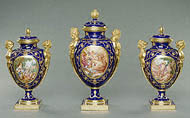 |
 |
 |
 |
Grades/Level: High School (9–12)
Subjects: Visual Arts, English–Language Arts, Science
Time Required: 3–5–Part Lesson
Three to four class periods
Author: J. Paul Getty Museum Education Staff
Permissions: 
The lesson plan and downloadable materials on this page are licensed under a Creative Commons Attribution 4.0 International License. |
 |
|
 |
 |
 |
 |
 |
 |
 |
Lesson Overview |
 |
Research activities investigate social science connections such as trade, societal impact, and style on the production and consumption of porcelain in the period leading up to the French Revolution. Extensions relate to chemistry connections. |
 |
 |
 |
 |
 |
Learning Objectives |
 |
Students should be able to:
• research the history of trade in porcelain wares from Asia and the quest to re-create true hard-paste porcelain in Europe.
• analyze the effects of production and consumption of luxury goods on French society in this period.
• compare and analyze the differences between hard-paste and soft-paste porcelain.
|
 |
 |
 |
 |
 |
 |
 |
 |
 |
Materials |
 |
• Image of Garniture of Three Vases from Sèvres Porcelain Manufactory
|
 |
 |
 |
 |
 |
|
|
 |
 |
 |
 |
 |
Lesson Steps |
 |
1. Using the following questions as a guide, have students research the origins of Chinese porcelain and the history of its trade to European countries. See below for information about porcelain.
• What properties made porcelain so appealing to European collectors?
• How long did Europeans try to find the composition of true hard-paste porcelain?
• What were the substitutes for hard-paste porcelain? Where did the substitutes originate?
• Where in Europe was the chemical compound of true hard-paste porcelain discovered? Who first discovered it?
2. Discuss what possible effects the quest for the production and consumption of luxury goods, such as porcelain, had on the social unrest that later developed into the French Revolution.
|
 |
 |
 |
| Garniture of Three Vases, Sèvres Porcelain Manufactory, 1781 |
 |
|
 |
 |
 |
 |
 |
 |
 |
Extensions |
 |
Through research and observation, have the students compare the chemical compound for soft-paste and hard-paste porcelain.
• What is the molecular structure of porcelain?
• How does the molecular structure of porcelain compare to other types of ceramics?
• What makes the two types of porcelain different?
• What was missing from the soft-paste recipe to make true porcelain?
• What is the difference in the molecular structure of hard-paste and soft-paste porcelain?
True hard-paste porcelain, made from kaolin (a fine white clay originally found in China and used to produce Chinese porcelain) and petuntse (a coarse clay sometimes called china stone), resists melting far better than other kinds of porcelain. For this reason, it can be fired at higher temperatures. At these extreme temperatures, the petuntse vitrifies, or melts, forming a nonporous, natural glass. The kaolin, which is highly resistant to heat, does not melt and therefore allows the item to hold its shape. The process is complete when the petuntse fuses itself to the kaolin. In cross section it is impossible to distinguish the body from the glaze.
Soft-paste porcelain was developed in Europe in an attempt to imitate Chinese hard-paste porcelain. Soft-paste has been made many different ways. One way of producing soft-paste porcelain is by mixing white clay with "frit"—a glassy substance that was a mixture of white sand, gypsum, soda, salt, alum, and niter. Soft-paste porcelain is fired at lower temperatures than hard-paste porcelain and does not completely vitrify—that is, it remains somewhat porous. Breaking a piece of soft-paste porcelain reveals a grainy body covered with a glassy layer of glaze. |
 |
 |
 |
 |
 |
 |
 |
 |
 |
Standards Addressed |
 |
Common Core Standards for English Language Arts
Grades 9–12
WRITING
Research to Build and Present Knowledge
7. Conduct short as well as more sustained research projects based on focused questions, demonstrating understanding of the subject under investigation.
8. Gather relevant information from multiple print and digital sources, assess the credibility and accuracy of each source, and integrate the information while avoiding plagiarism.
SPEAKING AND LISTENING
Comprehension and Collaboration
1. Prepare for and participate effectively in a range of conversations and collaborations with diverse partners, building on others' ideas and expressing their own clearly and persuasively.
2. Integrate and evaluate information presented in diverse media and formats, including visually, quantitatively, and orally.
Visual Arts Content Standards for California Public Schools
Grades 9–12 Proficient
3.0 Historical and Cultural Context
Understanding the Historical Contributions and Cultural Dimensions of the Visual Arts
Students analyze the role and development of the visual arts in past and present cultures throughout the world, noting human diversity as it relates to the visual arts and artists.
Diversity of the Visual Arts
3.3 Identify and describe trends in the visual arts and discuss how the issues of time, place, and cultural influence are reflected in selected works of art.
Social Science Content Standards for California Public Schools
Grades 9–12
Historical Interpretation
1. Students show the connections, causal and otherwise, between particular historical
events and larger social, economic, and political trends and developments.
Grade 10
4. Explain how the ideology of the French Revolution led France to develop from
constitutional monarchy to democratic despotism to the Napoleonic Empire.
Science Content Standards for California Public Schools
Grades 9–12
Chemical Bonds
2. Biological, chemical, and physical properties of matter result from the ability of
atoms to form bonds from electrostatic forces between electrons and protons and
between atoms and molecules. As a basis for understanding this concept:
a. Students know atoms combine to form molecules by sharing electrons to form
covalent or metallic bonds or by exchanging electrons to form ionic bonds. |
 |

|
 |
 |
 |



